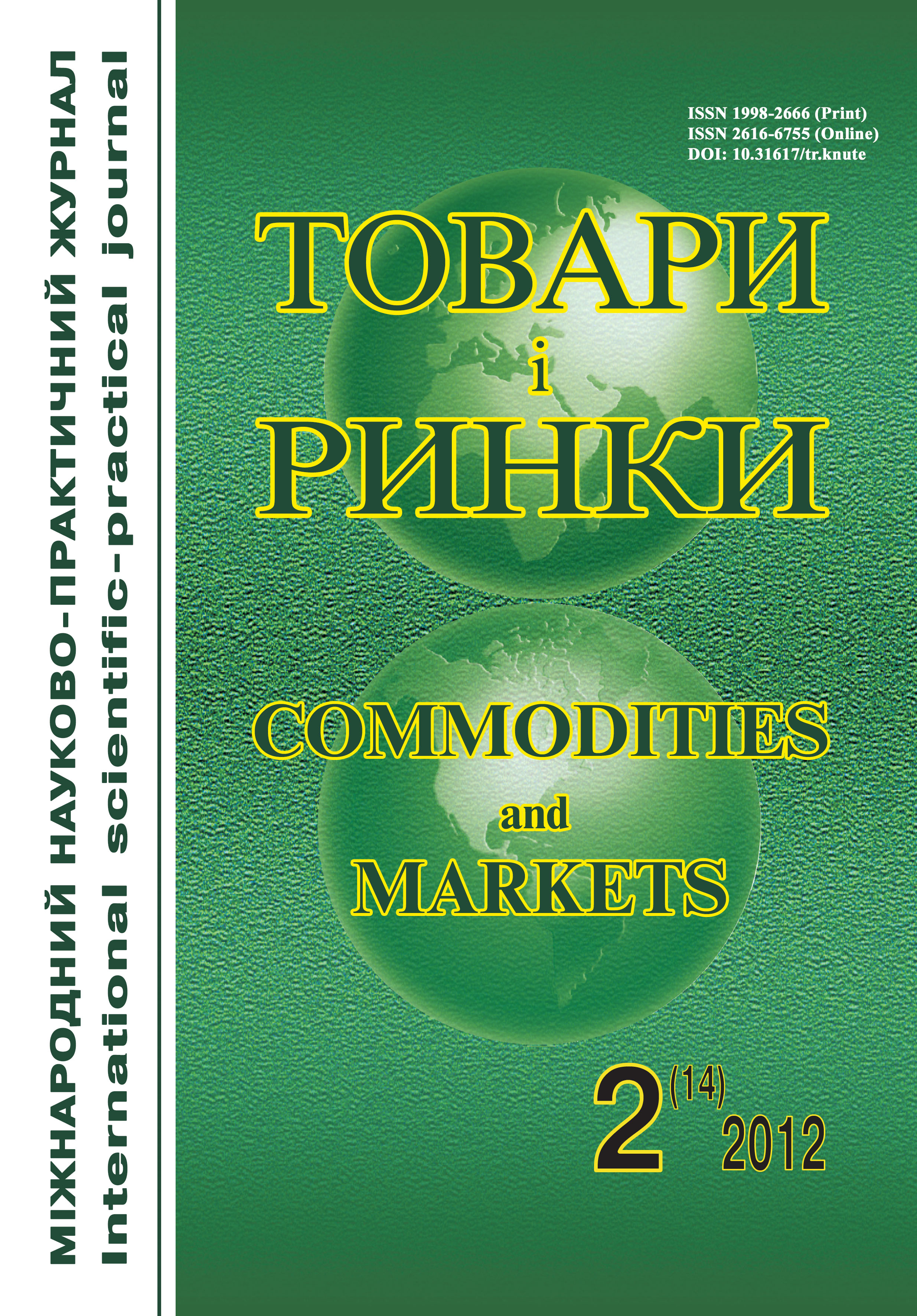Peculiarities of accumulating contaminants by vegetable crops
Keywords:
contaminants, garlic, eggplant, cabbage vegetables, rhubarbAbstract
The content of nitrates, radionuclides, salts of heavy metals in botanical sorts of garlic, aubergines, cabbages and rhubarb, which are spread and grown in Kharkiv area in the conditions of resource zones of the Institute of vegetable- and melon-growing of National Academy of Agrarian Sciences. The availability of specific and varietal specificity of the level of accumulating contaminants by vegetables is scientifically proved.
Garlic accumulates insignificant amounts of radionuclides and salts of heavy metals. The content of nitrates exceeded the MPC (Maximum Permissible Concentration) level 1.2–1.6 times in four sorts out of nine. All other contaminants are accumulated by garlic less intensively, and their amounts don’t exceed available concentrations. Cabbages, on the contrary, accumulate contaminants, primarily cadmium and nitrates.
The amount of nitrates, depending on the type of cabbages, fluctuates greatly: from 46.1 – in Brussels sprouts to 598.0 mg/kg – in Chinese cabbage. The amount of radionuclides for all types and sorts of cabbages is within the MPC limits, they are even 2–3 times less than in aubergines. All other sorts and types accumulate cadmium 1.2–2.4 times more than it is allowed. Its highest content is registered in Brussels sprouts.
The amount of other heavy metals contained is within the MPC limits. Rhubarb, like all early cultures, accumulates more contaminants. The amount of nitrates in rhubarb fluctuates a lot but does not exceed MPC norms. The limits of accumulating radionuclides are narrower, though their amount is higher in comparison with other vegetables (2–11 times) but does not exceed the allowed concentrations. The content of cadmium in rhubarb is within the MPC limits. Three sorts of rhubarb accumulate cadmium 1.5–2.5 times more than MPC, and only Monarkh sort contains it in the allowed amounts. Lead is accumulated in rhubarb in the admissible quantity, and only Krupnochereshkoyi sort exceeds level by 26 %. The same sort accumulates more copper. Other sorts accumulate copper 5–1.8 times less than MPC.
According to the level of accumulating nitrates in productive organs, the cultures under research are ranked in the following order: aubergine < garlic < cabbage < rhubarb. All samples of vegetables accumulate more caesium than strontium. Sorts of vegetables differ greatly by their ability to accumulate salts of heavy metals. The common feature for the investigated samples is that heavy metals can be ranked by the level of accumulation in the following order: zinc > copper > lead > cadmium. It is experimentally determined that the content of cadmium, one of the highly toxic metals, exceeds MPC in most investigated samples of cabbage and rhubarb. The differences between the sorts and cultures by the amount of nitrates, heavy metals and radionuclides are predetermined by their genotypic peculiarities.
References
Ильницкий А. П. Некоторые медицинские аспекты интенсификации сельского хозяйства / А. П. Ильницкий // Химизация сельского хоз-ва. — 1991. — No 11. — С. 13—17.
Товарознавчі аспекти підвищення безпеки харчових продуктів : моногр. / [А. А. Дубініна, Л. П. Малюк, Г. А. Селютіна та ін.]. — К. : ВД "Професіонал", 2005. — 176 с.
Пацюк Л. К. Консервы с радиозащитными и радиопротекторными свойствами для детей / Л. К. Пацюк // Пищевая пром-сть. — 1997. — No 10. — С. 38—39.
ГОСТ 269229−94. Сырье и продукты пищевые. Подготовка проб. Минерализация для определения содержания токсичных элементов. — Введ. 1998−01−01. — К. : Госстандарт Украины, 1997. — 16 с.
ГОСТ 30178−96. Сырье и продукты пищевые. Атомно-абсорбционный метод определения токсичных элементов. — Введ. 1998−01−01. — Минск : Межгосударственный совет по стандартизации, метрологии и сертификации, 1997. — 13 с.
Комплекс универсальный спектрометрический "Гамма плюс". Техническое описание и инструкция по эксплуатации. — М. : Эксперт центр, 1995. — 56 с.
Методика измерения активности γ-излучающих радионуклидов в счетных образцах с использованием программного обеспечения "Прогресс". — М. : ГП "ВНИИФТРИ", 1996. — 26 с.
Методика измерения активности β-излучающих радионуклидов в счетных образцах с использованием программного обеспечения "Прогресс". — М. : ГП "ВНИИФТРИ", 1996. — 27 с.
ГОСТ 29270−95. Продукты переработки плодов и овощей. Методы определения нитратов. — Введ. 1998−01−01. — К. : Госстандарт Украины, 1997. — С. 12—15.
Гинс В. К. Аккумуляция тяжелых металлов и металлоидов в нетрадиционных листовых овощных культурах: амаранте и овощной хризантеме при выращивании их на техногенно загрязненных территориях / В. К. Гинс, П. Ф. Кононков // V Междунар. научн. практ. конф. ["Интродукция нетрадиционных и редких растений"]. — М. : 2003. — Т. III. — С. 8—10.
Stroinski A. Some Physiological and Biochemical Aspects of Plant Resistance to Cadmium Effekt. 1. Antioxidative System / A. Stroinski // Acta Physiol. Plant. — 1999. — Vol. 21. — P. 175—188.
Кильчевский А. В. Экологическая селекция растений / А. В. Кильчевский, Л. В. Хотылева. — Минск : Технология, 1997. — С. 106—329.
Зубкова В. М. Роль корней при поступлении тяжелых металлов в растениях в условиях повышенной концентрации их в почве / В. М. Зубкова, В. А. Демин // Доклады РАСХН. — 2004. — No 1. — С. 23—27.
Казнина Н. М. Влияние Cd и Pb на рост, развитие и некоторые другие физиологические процессы однолетних злаков : дис. канд. ... биол. наук. : (03.00.12) : защищена 22.01.03 : утв. 15.07.03 / Казнина Наталья Мстиславовна. — Петрозаводск, 2003. –– С. 40—65.
Пути изучения наследственных факторов корневого минерального питания пшеницы. В кн.: Физиологические основы повышения эффективности минерального питания растений / [В. Н. Ходос, И. Н. Гудков, В. Ф. Чижко и др.]. — К. : Наукова думка, 1987. — С. 118—136.
Gobran G. R. Grace elements in the rhizospheve / Gobran G. R. [et al.] // CRC. — 2000. — 320 p.
Michalska M. In fluence of lead and cadmium on growth, heavy metal uptake, and nutrient concentration of three lettuce cultivars grown in hydroponic culture / M. Michalska // Communic. in Soil Sc. Plant Analysis. — 2001. — Vol. 32, N 3/4. — P. 571—583.
Борисов В. А. Качество и лежкость овощей / В. А. Борисов, С. С. Литвинов, А. В. Романова. — М. : АСТ, 2003. — С. 39—47.



